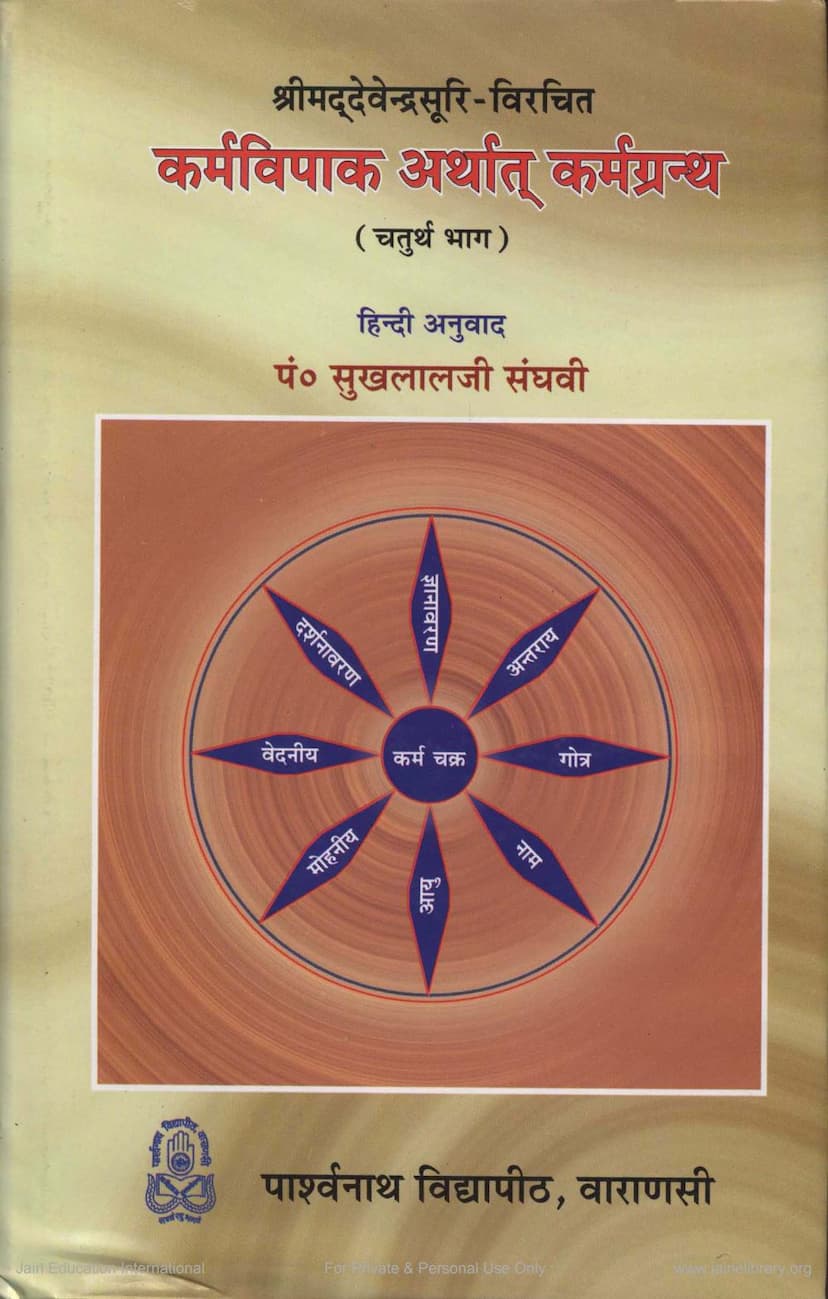Karmagrantha Part 4 Shadshitik
Added to library: September 2, 2025

Summary
The book you've provided information about is the fourth volume of the Karmagrantha series, titled "Shadshitik", authored by Devendrasuri and translated into Hindi with commentary by Pandit Sukhlal Sanghavi. Published by Parshwanath Vidyapith in Varanasi, it is the first reprinted edition from 2009.
Here's a comprehensive summary based on the provided text, focusing on its content and purpose:
Title and Authorship:
- Book Title: Karmagrantha Part 4 Shadshitik
- Original Author: Devendrasuri
- Hindi Translator & Commentator: Pandit Sukhlal Sanghavi
- Publisher: Parshwanath Vidyapith, Varanasi
- Series: Parshwanath Vidyapith Granthamala, No. 160
Core Subject Matter: The "Shadshitik" is the fourth of six Karmagrantha texts. Its name "Shadshitik" comes from the original text containing eighty-six verses (gathas). It's also referred to as "Sukshmartha Vichar" (Subtle Meaning Consideration) due to the author's mention of this term at the end. The text focuses on the intricate workings of karma as understood in Jain philosophy.
Purpose and Structure: The "Shadshitik" serves to resolve inquiries arising from the previous three karmagrantha volumes. While the earlier volumes dealt with the enumeration and effects of karma (Part 1), the disposition of karma in various stages of spiritual development (Part 2), and the specific karmic influences related to different spiritual stages within various existential conditions (Part 3), this fourth volume delves deeper into the interrelationships between:
- Jivasthanas (States of Souls): Classifying souls based on their existential forms, sensory faculties, and stages of development.
- Margana Sthanas (Paths of Investigation): Examining various conditions and characteristics of souls, such as their movement (gati), senses (indriya), physical bodies (kaya), mental and verbal activities (yoga), feelings (veda), passions (kashaya), knowledge (jnana), self-control (samyama), perception (darshana), karmic effulgence (leshya), potential for liberation (bhavyatva), right faith (samyaktva), and consciousness (sanjna/ahara).
- Gunasthanas (Stages of Spiritual Development): Detailing the fourteen stages of spiritual progress an soul undertakes, characterized by the gradual purification and manifestation of its inherent qualities.
The text elaborates on these core concepts, also touching upon Bhavas (states of existence) and Sankhya (numbers and quantities) related to these classifications.
Key Themes and Content:
- Interconnectedness of Jain Concepts: The book emphasizes how Jivasthanas, Margana Sthanas, and Gunasthanas are not isolated but deeply interconnected. For example, it explores how specific Jivasthanas are found within certain Margana Sthanas and how these are experienced across different Gunasthanas.
- Detailed Analysis: The text systematically analyzes over 80 topics related to these concepts, exploring aspects like the presence of Gunasthanas within Jivasthanas, the types of Yoga and Usage (Upayoga) associated with different conditions, the influence of L eshyas on karmic bondage, and the specific karmic bindings, emissions, and states (bandha, udveerna, sattva) within each context.
- Quantitative Aspects: A significant portion of the book is dedicated to quantifying these elements using Jain numerical concepts like 'sangyata' (countable), 'asankhyata' (incalculable), and 'ananta' (infinite), detailing their various classifications and methods of calculation, including the complex system of 'Palyas'.
- Spiritual Progression: A major focus is on the Gunasthanas, explaining the fourteen stages of spiritual evolution. This includes detailed discussions on the role of Moha (attachment/delusion) in hindering spiritual progress and how its gradual weakening leads to higher stages. The text also touches upon the different types of meditation (Dhyana) associated with each stage.
- Comparative Analysis: The introduction provides a comparative overview of similar concepts in Vedic and Buddhist philosophies, highlighting both the commonalities and distinctions with Jainism's approach to spiritual development.
- Author's Approach: Pandit Sukhlal Sanghavi's translation and commentary are noted for providing explanations and annotations for ordinary practitioners, alongside deeper insights for specialized scholars. He emphasizes the importance of reading the concluding appendices first for a general understanding of the topics and locations within the book.
- Scholarly Effort: The publication is presented as a revision and republication of an earlier work, made possible through the support of patrons like Shri Chaitanya Kochar and the dedicated efforts of editors and proofreaders.
In essence, "Karmagrantha Part 4 Shadshitik" is a profound and detailed exploration of Jain karma theory, breaking down complex concepts related to the soul's journey through different existential states and spiritual stages. It aims to provide a comprehensive understanding of how karmic laws operate and how spiritual progress is achieved, drawing upon a rich tradition of Jain philosophical literature.